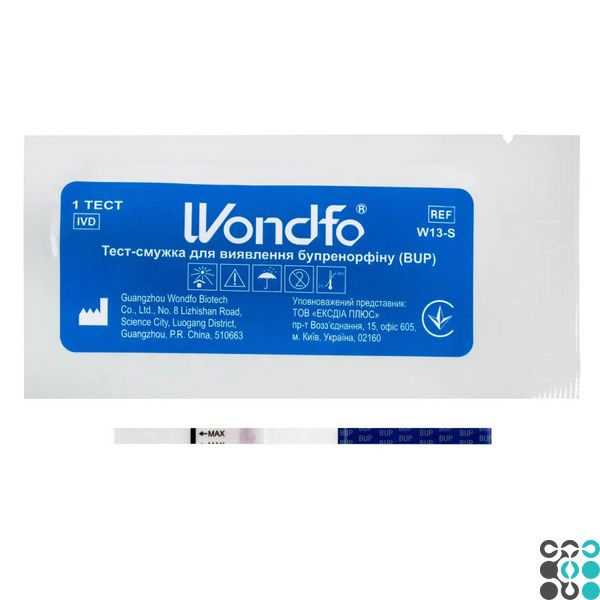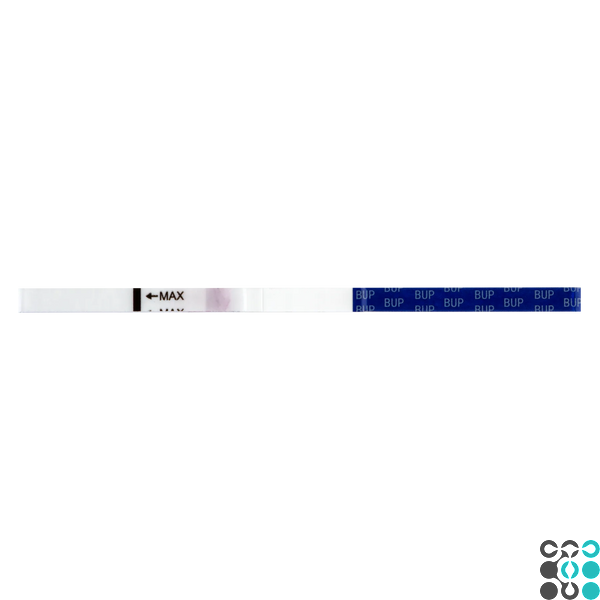|
Quantity
|
Out of stock
|
||
|
|
|||
DEFINITION
The Wondfo® Buprenorphine Detection Test (BUP) is an immunochromatographic assay for the determination of buprenorphine in human urine at a threshold concentration of 10 ng/mL.
BRIEF DESCRIPTION
Buprenorphine is a powerful painkiller that is often used in the treatment of opioid addiction. The drug is marketed under the trade names Subutex™, Buprenex™, Temgesic™ and Suboxone™, containing buprenorphine hydrochloride alone or in combination with naloxone hydrochloride. Therapeutically, buprenorphine is used in substitution therapy for opioid addicts. Substitution therapy is a form of medical care for opioid addicts (mainly heroin addicts), based on the use of substances similar or identical to the drugs previously used.
More...
In substitution therapy, buprenorphine is as effective as methadone but is less physically addictive. Urinary concentrations of free buprenorphine and norbuprenorphine can be as low as 1 ng/mL after therapeutic use, but can be as high as 20 ng/mL when abused. The plasma half-life of buprenorphine is 2-4 hours. While complete elimination of a single dose of the drug can take up to 6 days, the detection period for the original drug in urine is believed to be approximately 3 days.
The Wondfo® Buprenorphine Detection Test (BUP) is a rapid urine screening test that can be performed without equipment. The test uses monoclonal antibodies to selectively detect elevated levels of buprenorphine in urine.
The Wondfo® Buprenorphine Detection Test (BUP) is positive if the concentration of buprenorphine in the urine exceeds 10 ng/ml.
PRECAUTIONS
This test is for external use only. Do not swallow.
2. Dispose of after the first use. The test must not be used more than once.
3 Do not use the test kit after the expiration date.
4. Do not use the kit if the package is damaged or poorly sealed.
5. Keep out of the reach of children.
6. Do not evaluate results later than 10 minutes.
ASSAY KIT
One package contains the test and a moisture absorber.
The moisture absorber is for storage only and is not used in the analysis.
STORAGE AND STABILITY
Store at 2 ° C - 30 ° C in a closed container until expiration date.
Store in a place protected from direct sunlight, moisture and high temperature.
Do not freeze.
SAMPLE COLLECTION AND PREPARATION
Collect urine sample into a urine cup (container). Urine samples can be stored in the refrigerator (2 °C - 8 °C) for up to 48 hours. For longer storage, samples should be frozen (-20°C or lower).
Frozen or refrigerated samples must be brought to room temperature before testing. Use only pure aliquots for the test.
TEST PROCEDURE
The test should be performed at room temperature (10 °C to 30 °C)
1. Remove the test strip from the sealed package.
2. Immerse the strip in the urine so that the arrow points in the direction of the urine. Remove the strip after at least 10 seconds and place it horizontally on a clean, dry, non-absorbent surface (such as the neck of a urine container).
3. Evaluate the results after 5 minutes.
DO NOT interpret the test results later than 10 minutes.
IMPORTANT: Make sure that the urine level does not go beyond the MAX line (marking line), otherwise the test will not be performed correctly.
INTERPRETATION OF RESULTS
Positive (+)
A pale pink band is visualized in the test section. A colored band does not appear in the test site. A positive result indicates that the concentration of buprenorphine is at or above the limit of determination (10 ng/ml).
Negative (-)
A pale pink band is visualized in the control and test areas. A negative result indicates that the concentration of buprenorphine is zero or below the limit of determination (10 ng/ml).
Invalid
If the stained strip is not visualized in the control area, or if the stained strip is only visualized in the test area, the test results are invalid.
LIMITATIONS OF THE PROCEDURE
1. This test was developed for testing urine samples only. The efficacy of this test when using other samples has not been validated.
2. If tainted urine samples are used, erroneous results may be obtained. Strongly oxidizing agents such as bleach (hypochlorite) can oxidize drug samples. If a tampered sample is suspected, obtain a new sample.
3. This test is a qualitative screening test. It is not intended to quantify drug concentrations or intoxication levels.
















